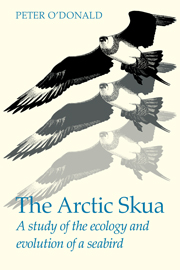Book contents
- Frontmatter
- Contents
- List of figures
- List of tables
- Preface
- 1 The Arctic Skuas of Fair Isle
- 2 Numbers and distribution
- 3 Feeding behaviour and ecology
- 4 Breeding ecology
- 5 Genetics
- 6 Demography and selection
- 7 Sexual behaviour
- 8 Sexual selection
- 9 Genetic models of sexual selection in birds
- 10 Mating preferences of the Arctic Skua
- 11 Conclusions
- Appendix A Rates of increase of bird populations
- Appendix B Analysis of variance of a 2 × r table with unequal numbers of observations
- Appendix C Statistical analysis of assortative and disassortative mating in polymorphic birds
- References
- Index
Preface
Published online by Cambridge University Press: 21 May 2010
- Frontmatter
- Contents
- List of figures
- List of tables
- Preface
- 1 The Arctic Skuas of Fair Isle
- 2 Numbers and distribution
- 3 Feeding behaviour and ecology
- 4 Breeding ecology
- 5 Genetics
- 6 Demography and selection
- 7 Sexual behaviour
- 8 Sexual selection
- 9 Genetic models of sexual selection in birds
- 10 Mating preferences of the Arctic Skua
- 11 Conclusions
- Appendix A Rates of increase of bird populations
- Appendix B Analysis of variance of a 2 × r table with unequal numbers of observations
- Appendix C Statistical analysis of assortative and disassortative mating in polymorphic birds
- References
- Index
Summary
This book describes the results of research spanning a period of 30 years. The late Kenneth Williamson began studying the Arctic Skuas of Fair Isle in 1948. Only 15 pairs were then nesting on the island. In 1957, Peter Davis took up the study, having succeeded Williamson as Warden of the Fair Isle Bird Observatory. As part of research for the Ph.D. degree of the University of Cambridge, I spent three years from 1958 to 1961 studying the genetics of the Arctic Skua. I was supported by a Nature Conservancy Research Studentship. This initial period of research on the Arctic Skuas ended in 1962 when Peter Davis left Fair Isle. By this time, 71 pairs were nesting on the island.
In 1970, R. J. Berry and Peter Davis published a paper analysing the breeding dates of the different phenotypes of the Arctic Skuas (Berry & Davis, 1970). They found that pale males, breeding for the first time, bred several days later on average than first-time, intermediate and dark males. They interpreted this as a behavioural adaptation of pale birds to their more northerly distribution where later breeding might be advantageous. At that time, I was working on models of Darwin's theory of sexual selection. The later breeding of certain male phenotypes in new pairs is exactly what the models predict, whereas the adaptation postulated by Berry and Davis should have been shown by all birds.
- Type
- Chapter
- Information
- The Arctic SkuaA study of the ecology and evolution of a seabird, pp. xiv - xviPublisher: Cambridge University PressPrint publication year: 1983



